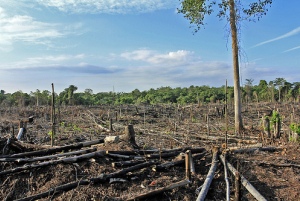What would it take to slow Sumatra's "forest transition"?

On May 7-11, CIFOR led a study tour through the provinces of West Sumatra and Riau in Indonesia. The trip, from Padang to Pekanbaru, covered a range of contrasting land uses from fishing, farming and small-scale agroforestry, to massive pulp and paper and oil palm plantations.
The pace of change has been particularly dramatic in Riau: forest cover has gone from 78% in 1982 to 33% in 2005. But other provinces and forests around the world are at risk as large scale investors seek more farmland. Will the "great sucking sound" coming from fast-growing global commodity markets leave room for diverse and resilient landscapes and communities? What livelihood options remain for people who have no formal land rights, who have seen their forest and river resources all but decimated, and are now stranded in an ocean of industrial-scale concessions? What chance does wildlife have of surviving what is known as the "forest and land use transition"? The elephants and tigers of Tesso Nilo National Park are certainly facing daunting odds. Will REDD+ do the trick? How about a tax on concessions to finance natural habitat protection? Could land reform level the playing field between investors and villagers?
We offer a set of photographs from the trip and two short interviews with CIFOR's Director General Frances Seymour. In return, please share your thoughts on these million dollar questions!








